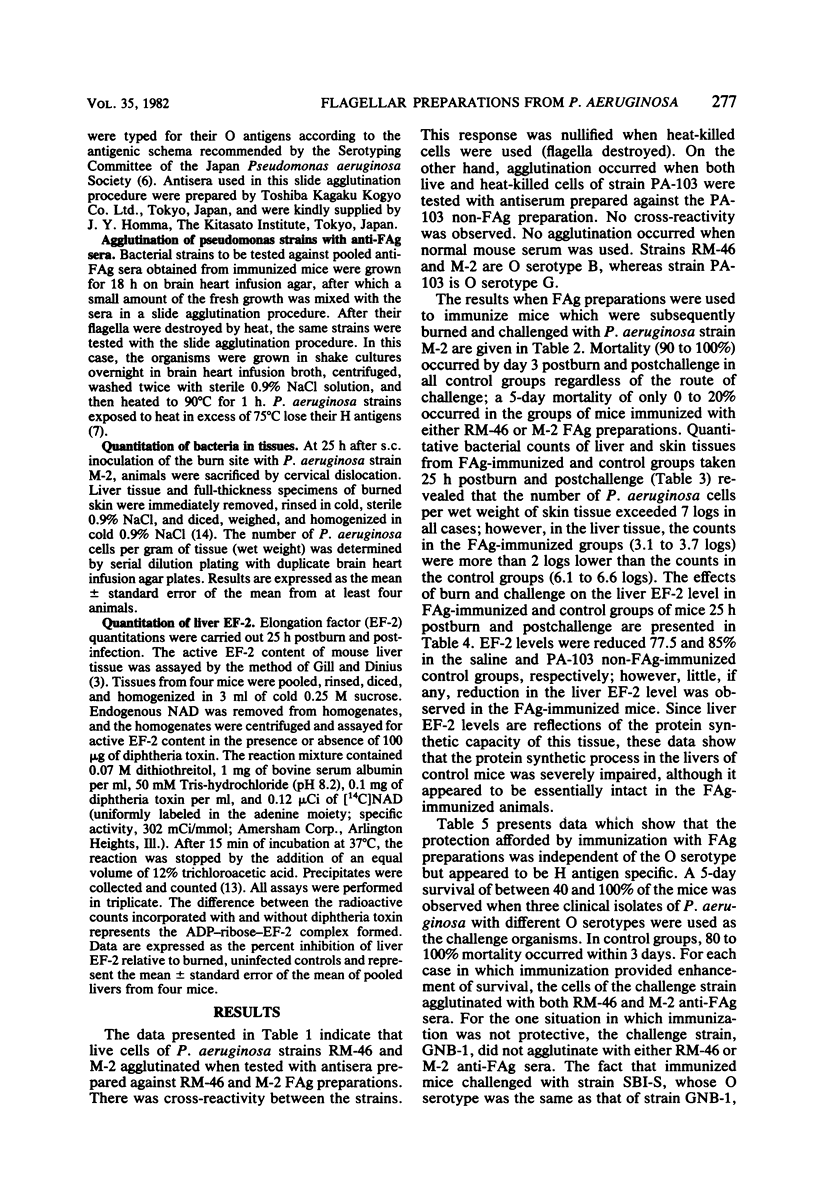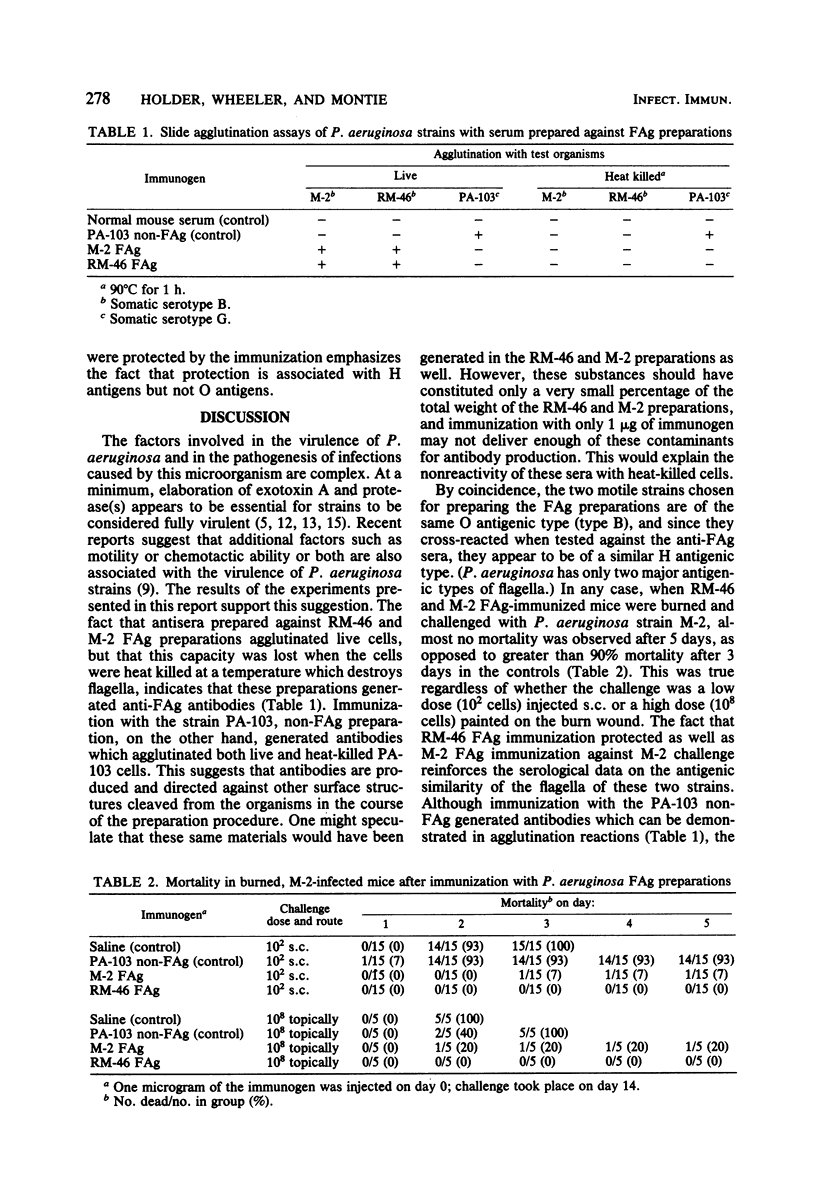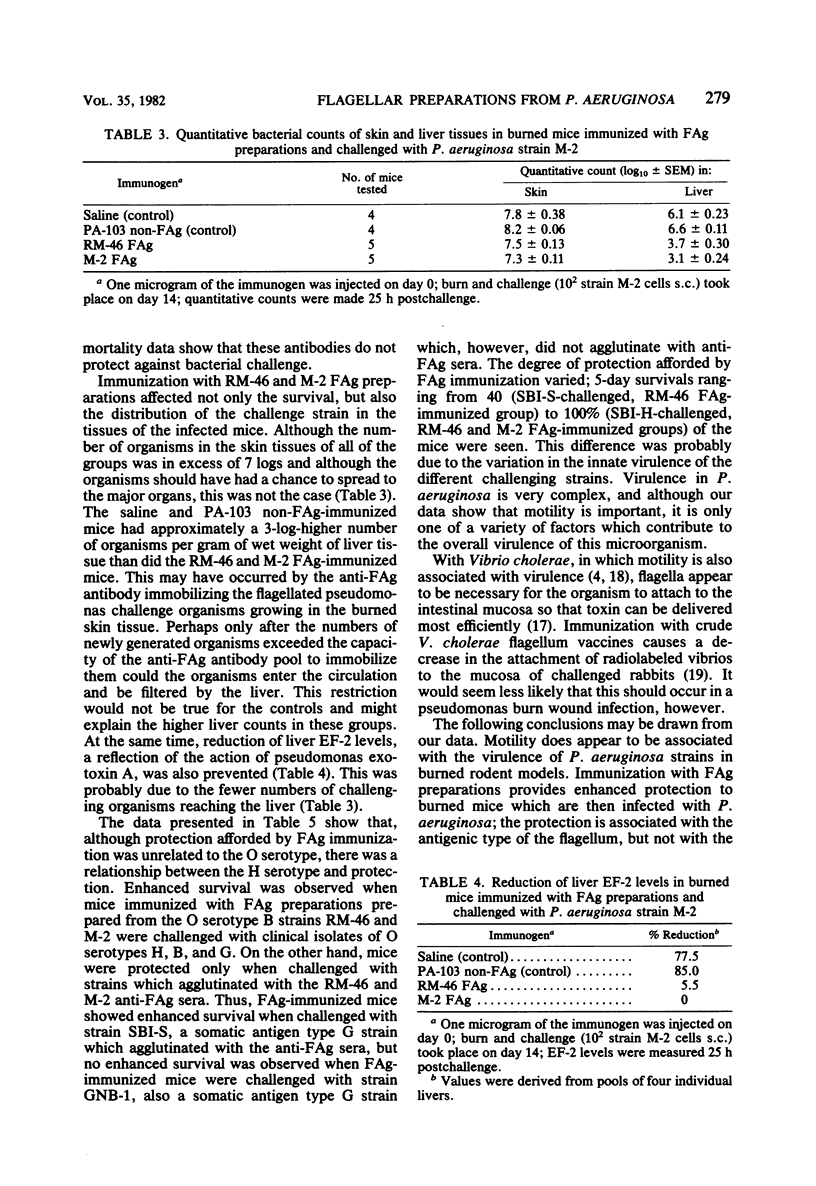Abstract
Recent reports have suggested that motility is associated with virulence in Pseudomonas aeruginosa. We have confirmed this observation by showing that groups of mice immunized with P. aeruginosa flagellar-antigen preparations display enhanced survival when they are subsequently burned and challenged locally in the burned area with strains of P. aeruginosa. The protection appears to be due to the immobilization of the microorganisms in the burned skin tissue. Liver elongation factor 2 is also protected. The protection afforded by immunization with flagellar-antigen preparations is independent of the somatic antigenic type of the challenging strain but is flagellar-antigen specific. These data suggest that vaccination with flagellar-antigen preparations may provide a viable prophylactic or therapeutic alternative to antibiotic therapy for use in compromised patient population in which P. aeruginosa poses a serious infection threat.
Full text
PDF




Selected References
These references are in PubMed. This may not be the complete list of references from this article.
- Ansorg R. Flagellaspezifisches H-Antigenschema von Pseudomonas aeruginosa. Zentralbl Bakteriol Orig A. 1978 Nov;242(2):228–238. [PubMed] [Google Scholar]
- Craven R. C., Montie T. C. Motility and chemotaxis of three strains of Pseudomonas aeruginosa used for virulence studies. Can J Microbiol. 1981 Apr;27(4):458–460. doi: 10.1139/m81-070. [DOI] [PubMed] [Google Scholar]
- Gill D. M., Dinius L. L. The elongation factor 2 content of mammalian cells. Assay method and relation to ribosome number. J Biol Chem. 1973 Jan 25;248(2):654–658. [PubMed] [Google Scholar]
- Guentzel M. N., Berry L. J. Motility as a virulence factor for Vibrio cholerae. Infect Immun. 1975 May;11(5):890–897. doi: 10.1128/iai.11.5.890-897.1975. [DOI] [PMC free article] [PubMed] [Google Scholar]
- Holder I. A., Haidaris C. G. Experimental studies of the pathogenesis of infections due to Pseudomonas aeruginosa: extracellular protease and elastase as in vivo virulence factors. Can J Microbiol. 1979 May;25(5):593–599. doi: 10.1139/m79-085. [DOI] [PubMed] [Google Scholar]
- Lányi B. Serological properties of Pseudomonas aeruginosa. II. Type-specific thermolabile (flagellar) antigens. Acta Microbiol Acad Sci Hung. 1970;17(1):35–48. [PubMed] [Google Scholar]
- Miller R. V., Becker J. M. Peptide utilization in Pseudomonas aeruginosa: evidence for membrane-associated peptidase. J Bacteriol. 1978 Jan;133(1):165–171. doi: 10.1128/jb.133.1.165-171.1978. [DOI] [PMC free article] [PubMed] [Google Scholar]
- Pavlovskis O. R., Wretlind B. Assessment of protease (elastase) as a Pseudomonas aeruginosa virulence factor in experimental mouse burn infection. Infect Immun. 1979 Apr;24(1):181–187. doi: 10.1128/iai.24.1.181-187.1979. [DOI] [PMC free article] [PubMed] [Google Scholar]
- Saelinger C. B., Snell K., Holder I. A. Experimental studies on the pathogenesis of infections due to Pseudomonas aeruginosa: direct evidence for toxin production during Pseudomonas infection of burned skin tissues. J Infect Dis. 1977 Oct;136(4):555–561. doi: 10.1093/infdis/136.4.555. [DOI] [PubMed] [Google Scholar]
- Saymen D. G., Nathan P., Holder I. A., Hill E. O., Macmillan B. G. Infected surface wound: an experimental model and a method for the quantitation of bacteria in infected tissues. Appl Microbiol. 1972 Mar;23(3):509–514. doi: 10.1128/am.23.3.509-514.1972. [DOI] [PMC free article] [PubMed] [Google Scholar]
- Snell K., Holder I. A., Leppla S. A., Saelinger C. B. Role of exotoxin and protease as possible virulence factors in experimental infections with Pseudomonas aeruginosa. Infect Immun. 1978 Mar;19(3):839–845. doi: 10.1128/iai.19.3.839-845.1978. [DOI] [PMC free article] [PubMed] [Google Scholar]
- Stieritz D. D., Holder I. A. Experimental studies of the pathogenesis of infections due to Pseudomonas aeruginosa: description of a burned mouse model. J Infect Dis. 1975 Jun;131(6):688–691. doi: 10.1093/infdis/131.6.688. [DOI] [PubMed] [Google Scholar]
- Yancey R. J., Berry L. J. Motility of the pathogen and intestinal immunity of the host in experimental cholera. Adv Exp Med Biol. 1978;107:447–455. doi: 10.1007/978-1-4684-3369-2_50. [DOI] [PubMed] [Google Scholar]
- Yancey R. J., Willis D. L., Berry L. J. Flagella-induced immunity against experimental cholera in adult rabbits. Infect Immun. 1979 Jul;25(1):220–228. doi: 10.1128/iai.25.1.220-228.1979. [DOI] [PMC free article] [PubMed] [Google Scholar]
- Yancey R. J., Willis D. L., Berry L. J. Role of motility in experimental cholera in adult rabbits. Infect Immun. 1978 Nov;22(2):387–392. doi: 10.1128/iai.22.2.387-392.1978. [DOI] [PMC free article] [PubMed] [Google Scholar]


